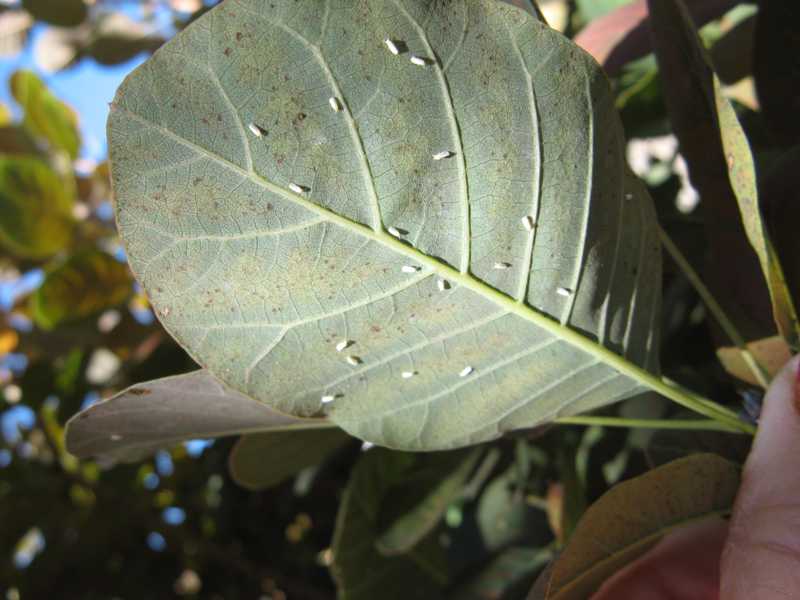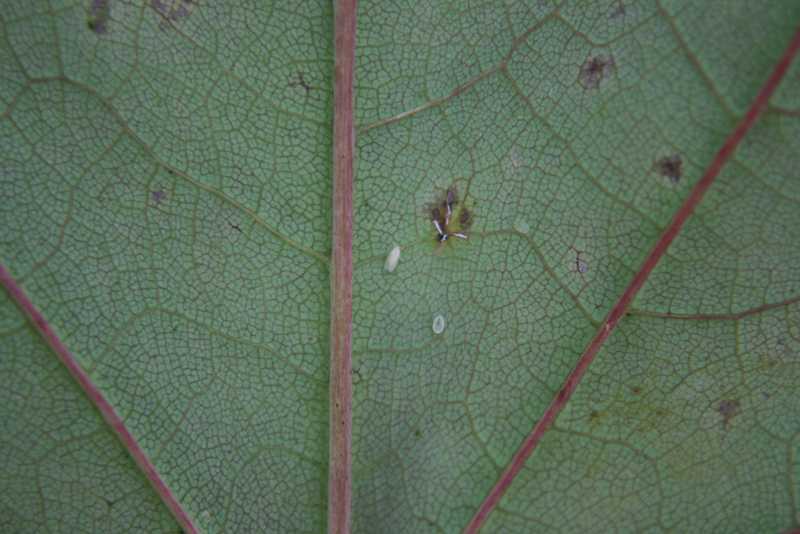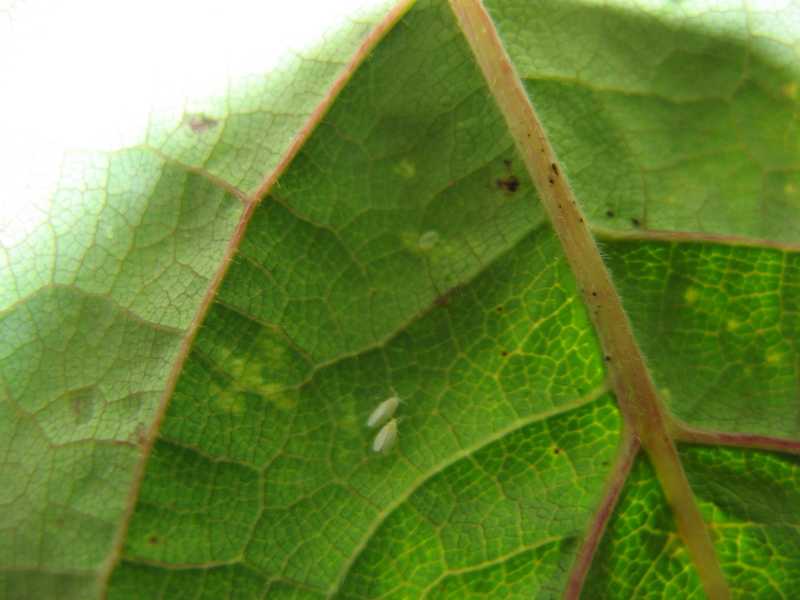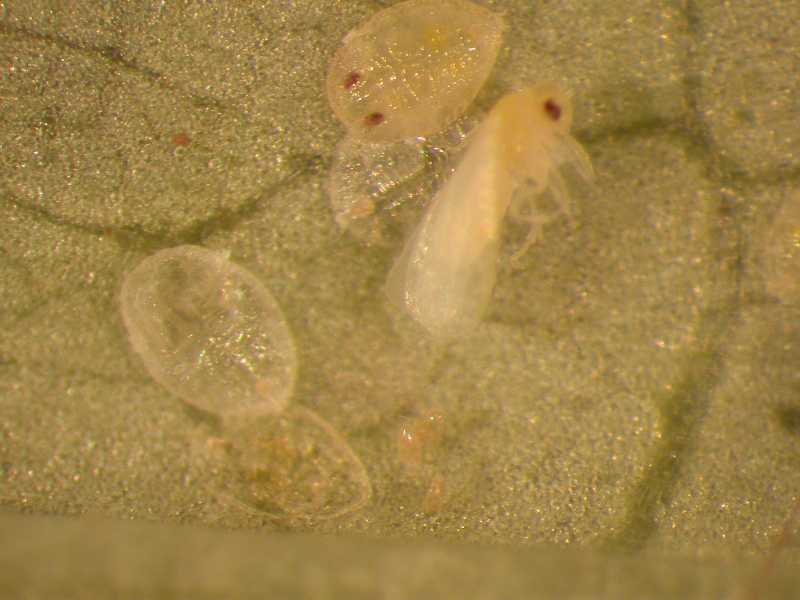 |
Whitefly (Hemiptera) on smokebush (Cotinus) |
There are over 1200 known species of whiteflies, most of which feed on only one or a few species of plants each. Some are pests on valuable crops such as the sweet potato whitefly (Bemisia tabaci). Others, like the greenhouse whitefly (Trialeurodes vaporariorum), feed on a broad range of herbaceous plants both inside the greenhouse and outside in the garden. Some of the host plants that the greenhouse whitefly attacks are the tomato, fuchsia, lantana, and coleus.
The silverleaf whitefly (Bemisia argentifolii) has been found on as many as 500 hosts such as canna lilies, bearded iris, crepe myrtle, lantana, petunia, and rose.
Whiteflies are one of the most difficult insect pests to control. They are not true flies but are more closely related to aphids, mealybugs, and scale, which are also sap-sucking insects. In some parts of the country, some species of whitefly can transmit several plant viruses.
Symptoms and Diagnosis
Identification of the whitefly is easy as a white cloud of insects rise from foliage when disturbed. The adults are about 1/16 to 1/10 inch in length, wedgeshaped, and appear powdery. Infested leaves may show little if any symptoms or may be mottled and yellow. Leaves will also become coated with a sticky substance called honeydew, which is secreted by feeding whitefly nymphs and adults. A black, sooty mold may sometimes grow on the honeydew. Sooty mold does not damage the leaf. The feeding, however, removes nutrients from the plant, which results in stunting, poor growth, defoliation, reduced yields, and sometimes death. On certain plants the silverleaf whitefly causes specific damage symptoms such as silvering of leaves on squash, irregular ripening in tomato, whitestalk in broccoli and cauliflower, light root in carrots, and white stem in poinsettia.
Life Cycle
The whitefly spends its winters in weeds and ornamental plants, migrating to crops and gardens in spring and summer. Once temperatures warm up in the summer, populations can build rapidly with the highest populations probably occurring in late summer. They lay their tiny eggs on the undersides of leaves. Adult females usually lay between 200 to 400 eggs. Sometimes the eggs are deposited in a circular pattern (not true in all species) in groups of 30 to 40 as the female will often keep her mouth part in the plant to feed while moving in a circle to deposit eggs. Within about a week the eggs hatch into flattened nymphs, called crawlers that wander about the plant. Soon, they insert their mouth part and begin to feed. The first stage has legs and antennae, but these are lost after the first molt and the flattened, oval-shaped larvae stay fixed at one feeding site. The last part of the fourth instar is the pupa. Adults emerge from the pupa through a Tshaped slit and soon mate and reproduce. The adults live about one month. Within a population, all life stages are present and generations often overlap.
Integrated Pest Management Strategies
1. Inspection. Inspect all new plants planted in the garden for whiteflies. Inspect regularly and remove by hand older leaves that are heavily infested with whiteflies in a non-mobile nymphal stage.
2. Biological control. Whiteflies have many natural enemies in the garden setting including spiders, lady beetles, and lacewings. However, these predators are not effective if there is a frequent use of insecticides.
3. Mechanical control. The use of traps can be very helpful in controlling light infestations. Make yellow sticky traps about 12 x 6 inches and coat them with a sticky substance such as Tanglefoot, petroleum jelly, or heavy grade motor oil. Hang the traps vertically near the affected plants. The adults are attracted to yellow. Traps are also commercially available. Use one trap per plant.
4. Chemical control. Whiteflies have developed resistance to some chemicals. Because of this resistance, a certain product may work well in one area but not in another. Resistance may be delayed by alternating the types of chemicals used. In addition, the egg and non-feeding pupa stages are generally not as susceptible to insecticides as are the adults and nymphs. Consequently, eradication of a whitefly population usually requires four to five applications of a registered insecticide at five to seven day intervals. Be sure the applications are made to the lower leaf surface, and apply as soon as whiteflies are detected. Do not wait until populations become severe.
Before using any insecticide for whitefly control, make sure that the site and target plant are both listed on the label. Follow label directions carefully.
5. Chemicals. Some of the over-the-counter chemicals which could be used are malathion, imidacloprid, permethrin, or pyrethrins. Insecticidal soap, petroleum oil, and insect growth regulators can also be effective.
Organic Strategies
Strategies 1, 2, and 3 are strictly organic approaches. For an organic approach to Strategy 5, consult the Organic Materials Review Institute (OMRI™) for appropriate pyrethrin and insecticidal soap products.
More images:
 |
| Whitefly (Hemiptera) in autumn on redbud (Cercis); adult and overwintering pupal form |
|
 |
| Whitefly (Hemiptera) on redbud (Cercis) |
|
 |
| Close-up of whitefly (Hemiptera) adult and pupae on sweet potato vine (Ipomoea batatas) |
|
|